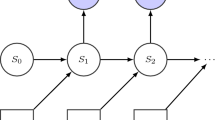Summary
Squirrel monkeys were trained to discriminate between the four permutations of a two-element sequence of colored lights (white and blue, A-B). Five teaching programs were developed to direct the animals' activity in an instrumental behavioral situation. In Program 5 the animals were confronted with all possible sequences in randomized order and were only rewarded if they pressed a lever in the B-part of sequence AB.
Analysis of the animals' strategies revealed different strategies in different animals when exposed to program 5, although the animals had undergone the same training previously: Random responding, responding to the second part of each sequence, responding to B in the second position of a sequence, responding after each stimulus A, and responding after each stimulus A in the first position of a sequence.
Four out of 7 animals reached the necessary strategy for real discrimination of sequences, namely “responding to B after a stimulus A”.
Three animals faited to advance beyond the strategy “responding after a stimulus A in the first position of a sequence”, which represents the closest strategy before real discrimination of the sequences.
The analysis performed makes it possible to find out which cues the animals use in the performance of the task, even if the animal has not yet reached true discrimination between sequences.
The experimental model has been developed for use as a sensitive instrument for the detection or assessment of changes in the temporal parameters of the learning process in experiments where manipulations of the central nervous system (lesions, drug) make such changes likely.
Zusammenfassung
Durch 5 Lehrprogramme wurden Totenkopfäffchen in einer instrumentellen Verhaltenssituation darauf trainiert, Sequenzen von zwei Lichtern (weiß und blau; A und B) voneinander zu unterscheiden. In Programm 5 wurden alle 4 Permutationen der Elemente A und B, also AB, BA, AA und BB als Lichtreize verwendet. Die Beantwortung von B in AB wurde belohnt.
Die Analyse der Strategien der Tiere in Programm 5 ergab verschiedene Strategien für verschiedene Tiere bei der Konfrontation mit den verschiedenen Sequenzen trotz des gleichen Vortrainings der Tiere: Zufallsbeantwortung, Beantwortung des zweiten Lichtes der Sequenzen, Beantwortung von B in 2. Position, Beantwortung nach jedem Stimulus A und jedes Stimulus A in 1. Position.
Von 7 Tieren erreichten 4 die für diese Diskriminierung notwendige Strategie „Beantwortung von B nach Stimulus A“.
3 Tiere verbliehen bis zum Schluß in der Strategie „Beantwortung nach einem Stimulus A in 1. Position“, die eine Vorstufe der Sequenzendiskriminierung darstellt.
Durch die durchgeführte Analyse ist auch eine Beurteilung von Beantwortungsschemata möglich, die noch keine Diskriminierung von Sequenzen darstellen und damit eine Beurteilung dessen ermöglicht, was einem Versuchttier von der dargebotenen Information relevant geworden ist. Das Verhaltensmodell ist entwickelt zur Verwendung bei verschiedenen Manipulationen im Zentralnervensystem (Ausschaltungen, Psychopharmaka), bei den Effekten in den zeitlichen Parametern des Lernprozesses zu erwarten sind oder beurteilt werden sollen.
Similar content being viewed by others
Literatur
Dewson, J. H., Cowey, A.: Discrimination of auditory sequences by monkeys. Nature (Lond.) 222, 695–687 (1969).
Jarosch, E.: Untersuchungen über die Einflüsse der sozialen Organisation der Totenkopfäffchen (Saimiri sciureus) auf das instrumentelle Lernen bzw. die selbstgewählte Reihenfolge in den Versuchen. Folia primatol. 9, 135–153 (1968).
Jarosch, E.: Social contacts and “task-directed” activity in the squirrel monkey (Saimiri sciureus). Recent Advanc. Primatology 1, 137–142 (1969).
Jarosch, E.: Echtzeitdokumentation von instrumentellen Verhaltensuntersuchungen mit Digitalcomputer. In Vorbereitung.
Jarosch, E., Leber, W., Nitsch, F. M.: Versuchssteuerung- und Registrier-system für instrumentelle Verhaltensuntersuchungen. Forma et Functio 4, 247–282 (1971).
Jarosch, E., Nitsch, F. M.: Experimente über „paradoxe” Wirkungen von Tranquilizern im Tierversuch. Int. Pharmacopsyehiat. 1, 168–183 (1968).
Jarosch, E., Nitsch, F. M.: Synchrone rhythmische Schwankungen der aufgabenbezogenen Aktivität von Totenkopfaffen (Saimiri sciureus) in optischen Diskriminierungsversuchen. Zool. Anz., Verh. Zool. Ges. 1968, 334–338 (1968).
Jarosch, E., Nitsch, F. M., Leber, W.: Schrittweise Synchronisation der aufgabenbezogenen Aktivität mit Lichtreizen als Lernprinzip bei Totenkopfäffchen (Saimiri sciureus) in optischen Diskriminierungsversuchen. Zool. Anz., Suppl. 33, Verh. Zool. Ges. 1969, 284–289 (1969).
Konorski, J.: A new method of physiological investigation of recent memory in animals. Bull. Acad. pol. Sci. Cl. 2 7 (3), 115–117 (1959).
Stepien, L. S., Cordeau, J. P.: Memory in monkeys for compound stimuli. Amer. J. Psychol. 73, 388–395 (1960).
Author information
Authors and Affiliations
Rights and permissions
About this article
Cite this article
Nitsch, F.M., Jarosch, E. Individuelle Lernstrategien von Totenkopfäffchen bei der Diskriminierung von visuellen Sequenzen. Psychol. Forsch. 35, 335–354 (1972). https://doi.org/10.1007/BF00424554
Received:
Issue Date:
DOI: https://doi.org/10.1007/BF00424554




